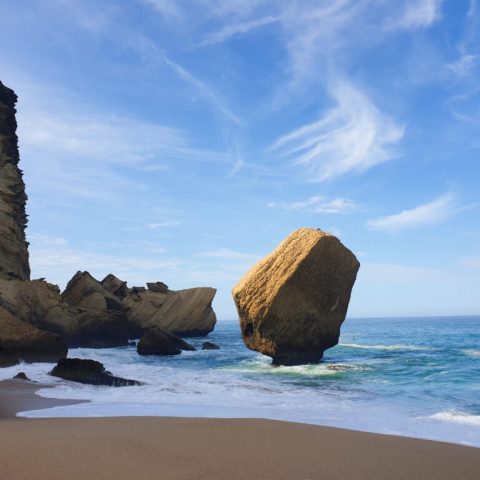Feast
Â
Reviewed by Shaun Ajamu Hutchinson
Â
Friday, February 8, 2013.
Â
Â
Feast is a
co-production between the Young Vic and the Royal Court Theatre, and its
conception is as important as the final product itself. The
Royal Court’s latest collaboration with Nigerian writers sparked an interest in
Cuba, which in turn inspired similar intrigue about Brazil, the USA and England
– all locations where descendants of enslaved Africans have established a
thriving diaspora.
Â
Feast is showcased as
part of the series World Stage London, with five emerging voices – Yunior
Garcia Aguilera (Cuba), Rotimi Babatunde (Nigeria), Marcos Barbosa (Brazil),
Tanya Barfield (USA) and Gbolahan Obisesan (UK) – all of whom must have had a
daunting brief. The ambitious work they
devised comprises of several concise vignettes that dramatize the journey made
by millions of Africans from Africa to the Americas, in addition to the
rituals, folklore and customs that crossed the Atlantic Ocean with them.
Â
Manifest
throughout the Americas – most notably the Caribbean and South America – the play is about a resilient Yoruba worldview and its
deep and lasting influence on people’s lives as well as the impact of this
worldview on the emergence of several nations and cultures in the New World. The
core belief of Yoruba people is that intangible but real traits and characteristics of
our humanity – resilience, courage, nerves – are overseen by Supreme Being
Oludumare and the Orishas or guiding spirits which help us navigate our
existence. Seen in the folklore of
Africa and the Americas it has its expression in syncretised religious and
cultural practices such as Voudon, Santeria, Candomblé
and similar belief systems throughout the hemisphere – often dismissed as
voodoo, mumbo jumbo or witch doctorry
– its living legacy negates any racist stereotypes.
Â
The
story begins in 1713 when sisters Yemaya, Oshun and Oya – symbolising the Orishas of
motherhood, beauty and the warrior spirit – are divided by a mischievous trickster
[Louis Mahoney’s Papa Legba] and captured by slave traders. The trio are reincarnated in the subsequent
centuries by versatile actors including Noma
Dumezweni, Michelle Asante and Naana Agyei-Ampadu. The characters rely on courage, versatility
and endurance – giving us in the process the perfect mix of effervescence,
physicality and spirituality – qualities which set the trend for the entire 115 minutes of this
show.
Â
Fusing
drama, dance and perfectly intercut visual imagery, Lysander Ashton’s animation,
photomontages, portraits, historical memorabilia and artefacts find their way
onto Katrina Lindsay’s fantastically designed set and costumes. Â
Â
Partly
raised in Nigeria – Rufus Norris’ dynamic direction personifies his own
enthusiasm, intrigue and curiosity for a culture and history he also explored
[alongside writer Gbolahan Obisesan] in his work on Wole Soyinka’s Death and
The King’s Horseman.
Â
The performance moves effortlessly between West
Africa, New York, Havana, Brazil and contemporary London punctuated seamlessly
by the music of Michael Henry and Sola Akingbola [also playing Drumming Esu] with
George Cespedes giving muscularity, grace and sensuousness to intricately
choreographed dance and movement. Â
Â
In
the final scene, the Babalawo who as the Chief Diviner of Yoruba people and who
communicates with the Orishas – turns out to be white man speaking fluent
Yoruba. This was a surprise but is shows how pervasive and deeply rooted the
Yoruba culture is – and by extension the traits symbolised the Orishas.
Â
The
confident and versatile 13 strong cast are outstanding with Daniel Cerqueira
[White Man], Kobna Holdbrook-Smith [Elegba] and Louis Mahoney [Papa Legba]
particularly charismatic. They are closely followed by Coral Messam [Dancing
Oya] and Ira Mandela Siobhan [Dancing Elegbara]. Â
Â
Equally
crucial are the three piece band silhouetted behind the set, but as important
to Feast as the Antilabas band were
to recent hit Fela! which also
portrayed features of the same Yoruba culture.
Â
Where
dialogue takes over from performance it is peppered with aphorisms and
allusions to Yoruba customs, rituals and guidelines [confront the chaos of life, look to your inner self, be yourself, acknowledge your ancestors, look to the future].
And with this element the only weakness of the show is apparent with some intricacies –
helpfully explained in the programme – overshadowed by the powerful visuals,
physical theatre and design.
Â
But
in truth the playlets are just that – brief sketches filled in by the much more
focussed dance and visual imagery. And it’s where the combined talents of
writers, performers and dancers are shown to best effect.
Â
Directed by Rufus Norris
Choreography by George
Cespedes
Set designed by Katrina
Lindsay
Young Vic
www.youngvic.org / 020
7922 2922
Until 23
February 2013
Â
Shaun Ajamu Hutchinson is The New
Black Magazine’s arts editor and a London-based freelance journalist.



